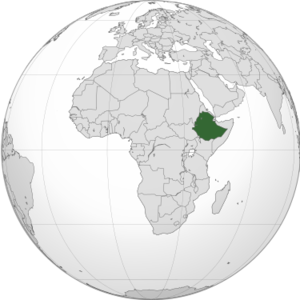Ethiopia
| Federal Democratic Republic of Ethiopia |
|
|
Source information is available at [ Sources ] |
Ethiopia, officially the Federal Democratic Republic of Ethiopia, is a country in the Horn of Africa and is the most populous landlocked country in the world. It shares borders with Eritrea and Djibouti to the north, Somaliland to the northeast, Somalia to the east, Kenya to the south, South Sudan to the west, and Sudan to the northwest. Ethiopia has a total area of 1,100,000 square kilometers (420,000 sq mi) and over 117 million inhabitants and is the 12th-most populous country in the world and the 2nd-most populous in Africa. The national capital and largest city, Addis Ababa, lies several kilometers west of the East African Rift that splits the country into the African and Somali tectonic plates.
History
Ethiopian national identity is grounded in the historic and contemporary roles of Christianity and Islam, and the independence of Ethiopia from foreign rule, stemming from the various ancient Ethiopian kingdoms of antiquity. Some of the oldest skeletal evidence for anatomically modern humans has been found in Ethiopia. It is widely considered as the region from which modern humans first set out for the Middle East and places beyond. According to linguists, the first Afroasiatic-speaking populations settled in the Horn of Africa region during the ensuing Neolithic era. Tracing its roots to the second millennium BC, Ethiopia's governmental system was a monarchy for most of its history. Oral literature tells that the monarchy was founded by the Solomonic dynasty from King Solomon and Queen of Sheba, under its first king, Menelik I. In the first centuries, the Kingdom of Aksum[Note 1] maintained a unified civilization in the region.
During the late 19th-century Western European Scramble for Africa[Note 2], Ethiopia established its modern borders through extensive conquest of territories to its east, west, and south. Ethiopia was the first independent African member of the League of Nations and the United Nations. Italy[Note 3] invaded in 1936 and established Italian Ethiopia as part of Italian East Africa until liberation in 1941 resulting in a short period of British military administration. During Italian rule, the government abolished the centuries-old practice of slavery, and urbanization steadily increased. In 1974, the long-standing Ethiopian monarchy under Haile Selassie was overthrown by the Derg, a communist military government backed by the Soviet Union. In 1987, the Derg established the People's Democratic Republic of Ethiopia, which was overthrown in 1991 by the Ethiopian People's Revolutionary Democratic Front (EPRDF). The EPRDF regime, dominated by the Tigray People's Liberation Front (TPLF), saw severe authoritarian, ethnic nationalist rule under an ethnic federalist system dominated by one-party, including human rights violations, political repression, and political prisoners, while the corruption rate steadily increased. During their rule, ethnic federalism was implemented in the constitution. The EPRDF coalition was merged with the new Prosperity Party of Abiy Ahmed in 2019 despite the TPLF refusing to merge. Since Abiy took office in 2018, ethnic tensions and unrest increased and hostility between Abiy's government and TPLF members worsened after 2020 and culminated in the Tigray War in November 2020.
Ethiopia is a multilingual nation, with around 80 ethnolinguistic groups, the four largest of which are the Oromo, Amhara, Somali, and Tigrayans. A majority of the population adheres to Christianity (mainly the Ethiopian Orthodox Tewahedo Church and P'ent'ay), while a third follow Islam, primarily Sunni. The country is the site of the Islamic Migration to Abyssinia and the oldest Muslim settlement in Africa, at Negash. The nation is a land of geographical contrasts, ranging from the vast fertile west, with its forests and numerous rivers, to the world's hottest settlement of Dallol in its north. The Ethiopian Highlands are the largest continuous mountain ranges in Africa, and the Sof Omar Caves contain the largest cave on the continent. Ethiopia also has the second-largest number of UNESCO World Heritage Sites in Africa. This sovereign state is a founding member of the UN, the Group of 24 (G-24), the Non-Aligned Movement, the G77, and the Organisation of African Unity. Addis Ababa is the headquarters of the African Union, the Pan African Chamber of Commerce and Industry, the United Nations Economic Commission for Africa, the African Standby Force, and many of the global NGOs focused on Africa.
In the 1970s and 1980s, Ethiopia experienced civil war and communist purges which hindered its economy but it has since recovered and, as of 2010, has the largest economy by GDP in East Africa. However, it remains one of the world's poorest countries, facing poverty, hunger, corruption, weak infrastructure, poor respect for human rights, and limited access to health and education, with a literacy rate of only 49%, ranking it in the worst quartile on the Human Development Index.
Spanking in Ethiopia
In the 20th century, school corporal punishment fell out of fashion and was gradually banned in many countries, a trend that continues until the present day.
As of May 2008, Ethiopia prohibits corporal punishment in schools..
Prostitution in Ethiopia
- Prostitution in Ethiopia ↗ on Wikipedia
Notes
- ↑ Aksum is also the alleged home of the holy relic the Ark of the Covenant. The Ark is said to have been placed in the Church of Our Lady Mary of Zion by Menelik I for safekeeping.[
- ↑ also called the Partition of Africa or the Conquest of Africa, was the invasion, occupation, division, and colonization of most of Africa by seven Western European powers during a short period known to historians as the New Imperialism (between 1881 and 1914).
- ↑ In 1935, Mussolini invaded Ethiopia and founded Italian East Africa, resulting in an international alienation and leading to Italy's withdrawal from the League of Nations; Italy allied with Nazi Germany and the Empire of Japan and strongly supported Francisco Franco in the Spanish civil war.
External links
- More information is available at [ Wikipedia:Ethiopia ]
Chat rooms • What links here • Copyright info • Contact information • Category:Root

